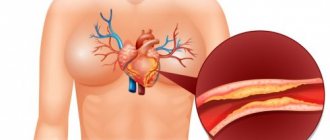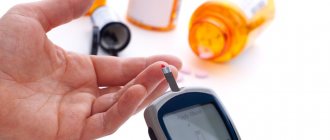Many people know that a cholesterol test is performed to diagnose lipid metabolism disorders and to assess the risk of developing a disease such as atherosclerosis. However, most do not have answers to these questions:
- Should this organic compound be present in the human body?
- In any quantity?
- Are the rates the same for men and women?
- Do cholesterol levels in women depend on hormone levels?
- What happens if the value is higher than normal or, conversely, lower?
And this is not the entire list of what a woman might think about when she hears about a cholesterol test. If questions arise, they should be asked to the appropriate specialist. But if this is not possible at the moment, then you can study at least basic information.
What does cholesterol look like?
Many people think of cholesterol as fat and believe that the fattier the food, the more cholesterol it contains. This point of view is only partly justified. Cholesterol is found in the blood and looks like a viscous substance. Cholesterol cannot be considered exclusively harmful, because it is consumed by the body in the process of producing hormones and forming cell membranes. To varying degrees, cholesterol is involved in the functioning of the immune, nervous and digestive systems, so a certain amount of cholesterol must be contained in the body at all times. Another thing is that keeping it within acceptable limits is not always easy.
Excess cholesterol
tends to deposit on the inner walls of arteries.
At first, this is an imperceptible process, but gradually, due to the cholesterol layer, the diameter of the artery narrows, and blood begins to pass through it worse. In places where the vessel narrows, a dense formation is formed from the cholesterol layer, which is commonly called a “ cholesterol plaque
.”
Cholesterol plaques not only almost completely block the flow of blood through the vessel, but also reduce its elasticity. The process of cholesterol formation is called “ atherosclerosis
”.
By themselves, single cholesterol plaques do not pose a serious health hazard, but if you do not take action, over time there will be too many of them. In addition, cholesterol plaque
- This is the initial stage of
thrombus
. Often blood clots form where atherosclerotic plaques were located. The danger of a blood clot is that it completely seals the vessels and can block the flow of blood to vital organs. If a blood clot occurs in a vessel supplying the heart, a person may have a myocardial infarction, and if blood flow stops in a vessel supplying the brain, the person may suffer a stroke.
Does high cholesterol cause death?
Cholesterol itself is not considered deadly. Complications caused by high cholesterol levels can lead to death. We have already named some of them. Atherosclerosis can trigger the development of coronary heart disease, and one of the complications can be myocardial infarction, stroke, acute thrombosis and other diseases. The list can be large and is determined by which arteries were affected.
Literature
- Anitschkow N. and Chalatow S. (1983). Classics in arteriosclerosis research: On experimental cholesterin steatosis and its significance in the origin of some pathological processes by N. Anitschkow and S. Chalatow, translated by Mary Z. Pelias, 1913. Arteriosclerosis, Thrombosis, and Vascular Biology
.
3 , 178-182; - Klimov A.N. Causes and conditions for the development of atherosclerosis. Preventive cardiology. M.: “Medicine”, 1977. - 260–321 pp.;
- Cox RA and Garcia-Palmieri MR Cholesterol, triglycerides, and associated lipoproteins. Clinical methods: the history, physical, and laboratory examinations (3rd Edition). Boston: Butterworths, 1990. - 153–160 p.;
- Grundy S. M. (1978). Cholesterol metabolism in man. West. J. Med. 128, 13–25;
- Wikipedia: “Lipoproteins”;
- Wójcicka G., Jamroz-Wisniewska A., Horoszewicz K., Beltowski J. (2007). Liver X receptors (LXRs). Part I: Structure, function, regulation of activity, and role in lipid metabolism. Postepy Hig. Med. Dosw. 61, 736–759;
- Calkin A. and Tontonoz P. (2010). Liver X Receptor signaling pathways and atherosclerosis. Arterioscler. Thromb. Vasc. Biol. 30, 1513–1518;
- S. Acton, A. Rigotti, K. T. Landschulz, S. Xu, H. H. Hobbs, M. Krieger. (1996). Identification of Scavenger Receptor SR-BI as a High Density Lipoprotein Receptor. Science
.
271 , 518-520; - Vrins C. L. J. (2010). From blood to gut: Direct secretion of cholesterol via transintestinal cholesterol efflux. World J. Gastroenterol. 16, 5953–5957;
- Van der Velde A. E. (2010). Reverse cholesterol transport: From classical view to new insights. World J. Gastroenterol. 16, 5908–5915;
- Wilfried Le Goff, Maryse Guerin, M.John Chapman. (2004). Pharmacological modulation of cholesteryl ester transfer protein, a new therapeutic target in atherogenic dyslipidemia. Pharmacology & Therapeutics
.
101 , 17-38; - Lipid foundation of life;
- Nanoparticles for “bad” cholesterol!
Is all cholesterol the same?
Cholesterol is found in the blood, but does not dissolve in it. Cholesterol is carried throughout the body by lipoproteins. High density lipoprotein (HDL) molecules
move cholesterol from the arteries to the liver. Later, this cholesterol is excreted from the body and is not deposited on the walls of blood vessels. Such cholesterol is considered “good” because it not only does not increase, but reduces the risk of developing cardiovascular diseases.
Another type of cholesterol carried by low-density lipoprotein (LDL) molecules
from the liver throughout the body. In peripheral tissues, cholesterol gradually settles on the walls of blood vessels, resulting in the formation of atherosclerotic plaques. It is important for a person to monitor and prevent an increase in the level of low-density lipoproteins, or “bad” cholesterol.
Another form of lipids that provide the body with energy, but in large quantities can be harmful, are triglycerides. They are synthesized by the liver or enter the body with food, and then pass into the blood. A high content of triglycerides in the blood is also undesirable, since it can disrupt the functioning of the circulatory system.
Upper and lower limits of normal for women. Table with main indicators
The data indicated in the table is for informational purposes only. To carry out tests, contact your local physician or a certified laboratory. IMPORTANT: only a doctor can correctly interpret the results, taking into account the patient’s medical history, her complaints (or lack thereof) and other diagnostic data.
| Age | Total cholesterol (TC), mmol/l | High-density lipoprotein cholesterol (good, HDL), mmol/l | Low-density lipoprotein cholesterol (bad, LDL), mmol/l | Triglycerides (TG), mmol/l |
| 15–20 years | 3,08–5,18 | 0,91–1,91 | 1,53–3,55 | 0,44–1,4 |
| 20–25 years | 3,16–5,59 | 0,85–2,04 | 1,48–4,12 | 0,41–1,48 |
| 25–30 years | 3,32–5,75 | 0,96–2,15 | 1,84–4,25 | 0,42–1,63 |
| 30–35 years | 3,37–5,96 | 0,93–1,99 | 1,81–4,04 | 0,44–1,70 |
| 35–40 years | 3,63–6,27 | 0,88–2,12 | 1,94–4,45 | 0,45–1,99 |
| 40–45 years | 3,81–6,53 | 0,88–2,28 | 1,92–4,51 | 0,51–2,16 |
| 45–50 years | 3,94–6,86 | 0,88–2,25 | 2,05–4,82 | 0,52–2,42 |
| 50–55 years | 4,20–7,38 | 0,96–2,38 | 2,28–5,21 | 0,59–2,63 |
| 55–60 years | 4,45–7,77 | 0,96–2,35 | 2,31–5,44 | 0,62–2,96 |
| 60–65 years | 4,45–7,69 | 0,98–2,38 | 2,59–5,80 | 0,63–2,70 |
| 65–70 years | 4,43–7,85 | 0,91–2,48 | 2,38–5,72 | 0,68–2,71 |
| > 70 years | 4,48–7,25 | 0,85–2,38 | 2,49–5,34 | 0,68–2,71 |
What increases cholesterol?
Increased cholesterol levels can be due to various factors. The first thing you should pay attention to is your diet
.
If a person has a slight increase in cholesterol levels, doctors usually recommend that they eat less foods high in saturated fat, but certain health problems can also contribute to high cholesterol levels. For example, chronic renal failure or decreased thyroid function. Some people may have high cholesterol levels “naturally” and be inherited. This genetic abnormality is called “ familial hypercholesterolemia
”.
When shaping your diet, you need to remember that cholesterol is found only in products of animal origin. This argument is often made in favor of a plant-based diet by vegetarians. However, this does not mean that if animal food is excluded, the rest of the diet can be uncontrolled. Food fried in vegetable oil and products containing palm oil can also have a negative effect on lipid metabolism.
Why does the cholesterol level for women change as they age?
Usually, when talking about high cholesterol, it is LDL levels that are meant. If you look at the entire table above, you can easily notice that with age, the level of the substance in the blood increases. Therefore, we can conclude that LDL (and not only them) are increasingly appearing in the blood. Of course, this is not a constant proportional increase upward. The increase occurs up to a certain age of the woman. After approximately 65 years, the concentration of cholesterol in the blood begins to fall along with the normal limits. Why does concentration increase with age? The question is good and simple, so the answer is short: the older a person gets, the more connective tissues grow in the body and fat deposits form, all this provokes an increase in cholesterol levels. It is for this reason that it is worth monitoring cholesterol, HDL, LDL and triglycerides throughout your life.
Do healthy people need to monitor their cholesterol?
Often people begin to monitor certain indicators when problems appear and their health worsens, but prevention is always better than cure. The concept of “healthy person” is too general. You may not have liver or metabolic problems now, but that doesn't mean you won't have them in the future. People with identified lipid metabolism disorders should regularly undergo cholesterol tests, but others should not check the strength of their body.
If your diet often contains fatty foods, high-calorie foods, and in general you like to indulge in sweets, then sooner or later this will increase your cholesterol. Other cardiovascular risk factors may also have an impact. As a result, you risk getting atherosclerosis with all the attendant consequences.
Cholesterol norm
If, according to the test results, your cholesterol is normal, then there is no serious cause for concern. Provided you follow the rules of a healthy diet and a healthy lifestyle, the next examination can be done in a few years.
If the cholesterol level is elevated ( from 5 to 6.4 mmol/l or more
), then it’s worth monitoring it every six months to observe the dynamics. At the same time, you need to reconsider your diet, remove foods that increase cholesterol, and also give up bad habits: smoking and drinking alcohol. Your doctor should warn you about additional risks associated with the presence of concomitant diseases.
over 6.4 mmol/l is considered a high-risk level.
. This indicator indicates the need for specialized treatment, since there is a high probability of developing coronary heart disease and other cardiovascular complications. The treatment program should be drawn up by a doctor based on the tests performed, including identifying the level of LDL, HDL and triglycerides.
Why is lipid metabolism disrupted in the body?
Lipid metabolism is a complex metabolic process. An important part is cholesterol metabolism. Its disorders are one of the main causes of cardiovascular diseases.
The disorder can occur for various reasons:
- heredity (in this case, the first symptoms appear in childhood);
- diseases of the gastrointestinal tract;
- endocrine pathologies;
- lack or excess of enzymes;
- kidney dysfunction;
- taking hormonal medications;
- bad habits;
- increased body mass index;
- physical inactivity.
For an adult, lipid metabolism disorders do not go unnoticed. Men experience hair loss prematurely, and women experience disruptions to their menstrual cycle. Excess cholesterol affects the condition of the skin and general well-being.
Risk group for atherosclerosis
Atherosclerosis
- an insidious disease that develops gradually. Cholesterol level is an indirect indicator of the risk of developing atherosclerosis, but some categories of people need to be tested for cholesterol at certain intervals. The following recommendations are given:
- men over 40 years old;
- women over 45 years old;
- people with diagnosed diabetes;
- overweight people;
- people with diseases of the thyroid gland, kidneys and high blood pressure;
- smokers;
- people who lead a sedentary lifestyle.
It is important to understand that at the first stage of development, atherosclerosis has no visible specific manifestations. A person may not even be aware of the developing disease and the problem with cholesterol. Therefore, doctors recommend regularly donating blood for biochemical analysis.
Causes of High Cholesterol
Causes of high cholesterol can be:
- overweight;
- eating large amounts of sweet and fatty foods;
- smoking;
- alcohol consumption;
- sedentary lifestyle;
- pregnancy.
High cholesterol is characteristic of certain diseases:
- congenital hyperlipidemia;
- pathologies of the hepatobiliary system;
- pancreas cancer;
- diabetes;
- hypothyroidism;
- kidney pathologies.
When should you start monitoring your cholesterol?
It's never too early for prevention. It’s better to get used to monitoring your health from a young age, then it will present you with fewer unpleasant surprises. It is especially important to pay attention to your health after 40 years of age
, this is true for both men and women. In men, coronary heart disease may begin to develop earlier than in women. This is explained by hormonal levels. Women of childbearing age have more “good” cholesterol in their bodies, while in men the preponderance may lean toward “bad” cholesterol. After menopause, women's bad cholesterol levels may also begin to rise along with their triglyceride levels.
If previously it was believed that atherosclerosis mainly affects mature and elderly people, now the disease is diagnosed in younger patients, so it would be reasonable to start controlling cholesterol levels at 30-35 years of age. If the analysis shows that everything is normal, a re-check can be carried out after 3-4 years, but if the cholesterol level is elevated or there is a genetic predisposition to the development of heart and vascular diseases, then it is worth checking the cholesterol level more often.
Do children suffer from high cholesterol?
Cholesterol levels in children, as a rule, do not rise above normal, but they can also be at risk if hereditary hypercholesterolemia is found in their family. In this case, the child will be registered with a pediatric cardiologist from an early age. A cholesterol test should be done at the age of two years, and then repeated periodically.
What is the danger of exceeding the norm?
The main complication of an increase in the amount of cholesterol in the body is considered to be atherosclerosis. This is damage to blood vessels by cholesterol plaques, due to which the lumen decreases and blood flow slows down. Usually the vessels and arteries of vital organs such as the heart, brain, and lungs are the first to suffer. If blood cannot circulate normally, then these organs suffer and their functionality is lost.
Atherosclerosis leads to the development of chronic heart pathologies. However, this disease is not the only possible complication. Due to excess cholesterol levels, the following may also develop:
- coronary heart disease - damage to the arteries through which oxygen passes;
- myocardial infarction;
- angina pectoris;
- stroke;
- other diseases of the cardiovascular system.
In particularly advanced cases, atherosclerosis and other complications can lead to the death of brain cells, heart cells, and cause human death.
Symptoms of high cholesterol
It is possible to determine the exact level of cholesterol in the body only after an analysis, but there are symptoms that may indicate the presence of disturbances in the functioning of the body. This will not allow you to make a diagnosis, but it should be a reason to visit a lipidologist or cardiologist. Make an appointment for a preventive appointment if:
- physical activity or excessive anxiety provokes the appearance of aching pain in the chest;
- even minor physical activity causes a feeling of lack of oxygen;
- you begin to get tired faster, and fatigue is accompanied by a feeling of heaviness in the chest area;
- you often have a headache for no reason, there is noise in your ears, you feel oxygen starvation to the point of fainting.
If you notice the symptoms described, make an appointment with your doctor. It will be enough to visit a therapist so that he can conduct a preventive examination and, if necessary, refer you to other specialized specialists.
The diagnosis of atherosclerosis is difficult to make without biochemical and instrumental examination, so be prepared for the fact that you will have to undergo a series of tests. The examination usually begins with a blood test and an ECG.
. Then, depending on the results obtained, a treatment program is prescribed, if necessary. The patient’s blood is usually taken from a vein, but if a quick result is needed, it can be obtained using the express method by drawing blood from a finger. To obtain more accurate results, it is recommended to donate blood on an empty stomach.
How to determine if the level of a substance is normal
Knowing what the normal level of total cholesterol is in an adult, you need to make sure that these indicators correspond to acceptable limits to prevent the development of atherosclerosis. Doctors direct patients to donate blood for biochemical analysis in cases of suspected diseases of the heart and blood vessels, hepatic and renal systems, or disruption of the endocrine system.
You need to properly prepare for the blood sampling procedure so that the readings are not distorted. You should go to the clinic on an empty stomach, but you should not fast for a long time (more than 12-14 hours in a row). Before taking a biochemistry test, you should not eat foods rich in animal fats, such as sausages, sauces, margarine, kebab, lard, etc.
You should also avoid active physical activity - this leads to an increase in the concentration of HDL in the blood plasma, which causes the analysis result to be distorted. The patient’s intake of any medications should not go unnoticed by the specialist, as this affects the conditions for the test.
For example, if a woman is protected using oral contraceptives, her LDL level in the blood may be increased, and total cholesterol may be decreased due to estrogen intake. The use of diuretics also affects the body in a similar way.
Some patients worry that donating blood from a vein will be painful or unpleasant. Doctors advise such emotional people to come to the laboratory early so as not to wait in line and not aggravate their unstable emotional state.
After the procedure, it is advisable to immediately go out into the fresh air to restore good mental health. Although there is nothing wrong with donating blood from a vein, the procedure is painless, and the result can be obtained after 1-2 days (the analysis for the biochemical composition takes a little longer than usual to prepare).
Modern laboratories test blood for cholesterol using several methods:
Cholesterol test interpretation
- titrometic - the researcher measures the exact concentration of the reactive substance and measures its amount that was necessary for the chemical reaction;
- gravimetric - based on measuring the mass of an individual component;
- nephelometric – during research, light particles are scattered in an opaque medium;
- chromatographic – a laboratory assistant studies the movement of particles under different conditions (moving and stationary medium);
- polarographic – aimed at determining the volume of total and free cholesterol among enzymes;
- fluometric - the substance is exposed to ultraviolet irradiation, then the level of its luminescence is studied;
- enzymatic - the volume of a certain component in the blood is determined by the content of fermentation products;
- color reaction - based on colorimetric methods.
The indicators that a person sees on the blood test decoding form cannot be interpreted independently. The indicated volume of HDL, LDL, triglycerides can mislead the patient, although on each form below it is written that the results will vary depending on the research methodology used.
Increased or decreased indicators as a result of analysis
A normal level of cholesterol in the blood does not mean that a person eats right, pays attention to sports, does not smoke or abuse alcohol. The amount of an organic compound indicates the presence or absence of concomitant diseases and pathological changes in the functioning of the heart and blood vessels.
There are a number of factors that can affect total cholesterol levels in the blood. For example, they grow during pregnancy in women, when protected by oral contraceptives, as a result of excess weight or a hereditary tendency to become obese.
In men, cholesterol increases as a result of frequent drinking, smoking and eating fatty foods. Bypassing all these factors, a persistent increase in the amount of cholesterol in the blood may indicate the following problems:
- initial or active stage of vascular atherosclerosis;
- pathologies of the kidneys and hepatic system;
- dysfunction of the pancreas with the threat of developing non-insulin-dependent diabetes;
- pancreatitis;
- gout;
- acute inflammatory processes in the body, which a person can only guess about (the transcript of the analysis in such cases indicates an increased level of HDL).
But not only an increase in the volume of cholesterol in the blood plasma is considered dangerous, a decrease in levels is also undesirable, since the organic compound is involved in almost all vital processes in the human body. Scientists have long come to the conclusion that a drop in cholesterol is often associated with depression and frequent stress.
In addition to an unstable emotional background, an unbalanced diet with a lack of vitamins and taking drugs of certain groups (for example, interferon) can lead to a decrease in cholesterol. The problem occurs in people suffering from chronic heart failure, excessive production of thyroid hormones, tuberculosis and other infectious diseases.
Beneficial properties of cholesterol (cholesterol)
Many people, considering cholesterol to be quite harmful to the body, do not know that without cholesterol, human development at the cellular level is impossible, and the vital functions of the body and smooth metabolism depend on cholesterol:
- Cholesterol is the building material for all cell membranes, and gives the membranes elasticity and strength;
- Cholesterol is responsible for the permeability of cell membranes, which helps improve the functioning of the immune system;
- Without cholesterol, the adrenal glands do not synthesize steroid-type hormones and other sex hormones;
- Cholesterol converts sunlight into vitamin D using liver cells, and also helps in the production of vitamin A, vitamin E and C;
- Cholesterol takes part in the production of bile acids. The production of bile takes up to 75.0% of all the cholesterol needed by the body;
- Cholesterol molecules interact at the cellular level between neurons in the spinal cord and brain;
- Protect nerve fibers from the influence of the external environment with the help of a hard shell;
- Cholesterol (cholesterol) increases the functionality of the immune system and helps the body fight off infection.
Cholesterol standards
What is the difference between cholesterol and cholesterol?
Many people, having heard about the dangers of cholesterol on the body, wonder if cholesterol may not be as harmful as cholesterol. What is the difference between these two molecules? These two substances have the same formula and are therefore one and the same.
Just the name cholesterol, most often used in world medicine and in scientific laboratories. The ending in the word cholesterol - “ol”, confirms its insolubility in liquids.
Cholesterol and cholesterol are crystals in a liquid state that are classified as fat-containing alcohol. Therefore, there is no difference between the two fatty alcohol molecules.
Cholesterol and cholesterol are crystals in a liquid state
Treatment and prevention
The diet is aimed primarily at reducing the total body weight of a person:
- It is advisable to exclude offal, as well as fatty fish and meat. Preference is given to chicken and turkey meat, lean varieties of beef are acceptable;
- Cottage cheese, yogurt, sour cream, kefir with a high percentage of fat content are removed from the diet, low-fat fermented milk products are allowed, but not more than once a day;
- the maximum permissible percentage of fat content for cheese should not exceed 30;
- The yolks are extracted from boiled eggs, the whites can be consumed in unlimited quantities;
- It is recommended to significantly reduce the amount of salt consumed;
- sweets are kept to a minimum, ideally eliminated completely;
- Products that are strictly prohibited include: sunflower oil, mayonnaise, and sauces.
The preferred cooking method is boiling, stewing or steaming; frying will have to be excluded. It is recommended to eat on a schedule, no more than five times a day.
Recent studies conducted by scientists in the USA have made it possible to establish a direct relationship between the type of coffee consumed and the value of the indicator in question. Thus, instant coffee has an increasing effect, so people with hypercholesterolemia are recommended to drink exclusively natural coffee without sugar.










